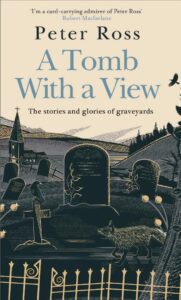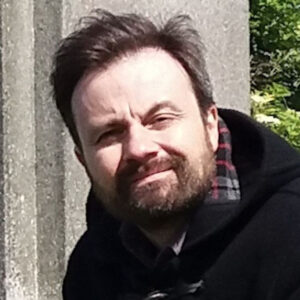By Peter Ross; reviewed by Jeannette Hartman

Journalist Peter Ross does more than list cemeteries and celebrity graves in this book; he celebrates lives.
He roves from London’s famed Victorian cemeteries to isolated military graves in northern Scotland to the hidden cillín where unbaptized babies are laid to rest in Ireland.
Among his stops are World War I battlefields where the remains of some of the nearly 100,000 British and Commonwealth soldiers still missing are being exposed by roadwork and land development.
New uses for old places
With cremation preferred by nearly 75 percent of those who die in the United Kingdom, cemeteries face uncertain futures. Many are full or nearly so. People who would like to be buried there can’t. No new interments means no income for maintenance. It also means fewer visitors.
As a result, new trends are developing. Some cemeteries have become venues for special events such as weddings, receptions, movie screenings or parties. Liz Webb and Shaun McHale, for example, decided to get married on Halloween in Arnos Vale Cemetery in Bristol.
Tombstone tourism is also a growing. Greyfriars Kirkyard is a favorite destination. First, because of the story of the loyal Cairn terrier, Greyfriars Bobby. But author J. K. Rowling drafted parts of her Harry Potter novels in the Elephant House cafe overlooking the cemetery. The kirkyard inspired Godric’s Hollow where Harry’s parents were buried. Rowling selected names from tombstones for character names.
Saving cemeteries from ruin
As cemeteries run out of space and funds, they fall into ruin. Warriston Cemetery, a 14-acre site in Endinburgh hidden from the street by a wall, is one such case.
Long full, it had become a “a lawless jungle” for drug deals and crime, “Edinburgh’s id.” At least until Bob Reinhardt, an American art teacher, discovered it and fell in love with it. For 20 years, he spent his school holidays exploring Edinburgh’s historic burial grounds.
He became so attached to the ivy and old stone of Warriston that he has taken 60,000 photographs of it. These have become guides for restoring the old cemetery. Reinhardt created a support organization that meets regularly to pick up trash and prune bushes. Today, it is a place where people can safely walk and enjoy nature.
One of the most moving stories Ross tells is that of Shane MacThomáis, a guide at Dublin’s Glasnevin Cemetery and the star of the documentary “One Million Dubliners” (2014), directed by Aoife Kelleher.
“It is a wonderful film with two stars, one of flesh and blood, the other of earth and stone: Shane and the cemetery itself. . . His love for Glasnevin and the force of his personality are such that you spend the first 80 minutes of the film falling for the guy.”
Suffering from depression, MacThomáis hung himself from a tree in Glasnevin. He was buried there with his father who had died 12 years earlier.
The film doesn’t explain how Shane died, but it’s a “kick in the guts: the slow coming into focus of his nameplate on the coffin. It is beautifully done. (Showing) he had joined the multitude whom he once hymned, gone beneath the earth over which he had walked with such purpose and passion.”
How churchyards became cemeteries
Originally, people were buried in graveyards near their neighborhood church. But as people flocked to the cities and plaques like cholera killed hundreds of thousands, churchyards became cesspits.
Some London churchyards so overcrowded by the bodies of cholera victims that the bones shifted into the basements of nearby buildings. Graves barely had dirt to cover the bodies. Rats, rain and on-going burials scattered bones far from corpses’ original resting places. The stench was so bad that many believed it alone could kill people.
A new trend came about: dedicated cemeteries built outside the city in park-like estates. All of London’s “Magnificent Seven” (Abney Park, Brompton, Highgate, Kensal Green, Nunhead, Tower Hamlets and West Norwood cemeteries) grew out of this trend.
Green burials
People are choosing cremation over burial. There is no longer enough land to do burials in a traditional way. Mourners no longer want impersonal and budget-breaking funerals run by professional funeral directors.
Until recently, there haven’t been many choices. Rupert and Claire Callender, owners of the Green Funeral Co., are part of a new trend to make funerals more personal and burials more ecological.
For clients of funeral homes like the Callenders’, this can mean a hands-on approach in which the bereaved help prepare a body for burial, plan and run the service and do the burial. A green funeral may involve no embalming and a casket that is biodegradable, becoming part of the earth like the body itself does.
A celebration of life
“This book, like the best sort of funeral, will be a celebration, not a lament. it will uncover the stories and glories of the best graveyards, from grand cities cemeteries to couthy country churchyards. I love all these places. I love the bones of them. I want to make you love them too,” Ross writes.
He succeeds brilliantly with this well-written fascinating book. It’s worth rereading and certainly would be an excellent companion for a visit to England, Scotland or Ireland.
The Author: Peter Ross
 Freelance journalist Peter Ross has won nine times at the Scottish Press Awards and been shortlisted for the Orwell journalism prize. He is a regular contributor to the Guardian and The Times.
Freelance journalist Peter Ross has won nine times at the Scottish Press Awards and been shortlisted for the Orwell journalism prize. He is a regular contributor to the Guardian and The Times.
He also is the author of the nonfiction collections of reporting, DAUNDERLUST and THE PASSION OF HARRY BINGO. The latter was shortlisted as nonfiction book of the year at the Saltire Society Literary Awards.
He lives in Glasgow with a view of the tombs. He has worked as a journalist in Scotland since 1997.
#peterross #tombwithaview #jeannettehartman


